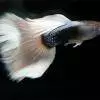Platy fish - Xiphophorus maculatus
Scientific name: Xiphophorus maculatus
Common name: Platy fish
Family: Poeciliidae
Usual size in fish tanks: 5 - 8 cm (1.97 - 3.15 inch)
014
Recommended pH range: 7 - 8.3
Recommended water hardness: 12 - 18°N (214.29 - 321.43ppm)
0°C 32°F30°C 86°F
Recommended temperature range: 20 - 26 °C (68 - 78.8°F)
The way how these fish reproduce: Pseudo-Livebearer
Where the species comes from: Central America
Temperament to its own species: peaceful
Temperament toward other fish species: peaceful
Usual place in the tank: Middle levels
Feeding
Platy fish are omnivorous and will eat almost anything small enough to fit in their mouths. To ensure they stay healthy and display their brightest colors, feed them high-quality flake or granulated food as the staple of their diet. Occasionally, supplement their diet with live or frozen foods such as daphnia, bloodworms, and brine shrimp. These treats provide important nutrients and help maintain their vitality. Feed your platies 1-2 times daily in small portions that they can consume in 2-3 minutes. Overfeeding can lead to poor water quality and health issues, so remove uneaten food after feeding.
Origin
The Platy fish (Xiphophorus maculatus) is native to Central America, where it can be found in creeks, springs, canals, ditches, and swamps from southern Mexico to Honduras. Over time, platies have also been introduced to various regions, including some U.S. states like Florida and Hawaii. Their adaptability has allowed them to thrive in different environments.
Sexing
Identifying the sex of platies is straightforward. Males are generally smaller and slimmer, and they have a pointed anal fin called a gonopodium, which is used for reproduction. Females, on the other hand, are larger, rounder, and have a more typical, rounded anal fin. Platies reach sexual maturity early, often around 4 months of age, making them prolific breeders.
Breeding
Platies are pseudo-livebearers, meaning that while the female doesn’t lay eggs externally, the eggs are fertilized and develop inside her body. Once fully developed, the female gives birth to live, free-swimming fry. Breeding platies is easy - simply house at least one male and one female in the same tank, and nature will take its course. Females can give birth to up to 60 fry every 5 weeks. To avoid overcrowding, it's important to have a plan for managing the population. Platies can be prolific breeders, so it’s important to provide hiding places like Java moss or dense plant cover for the fry to hide from adult fish. Fry can be fed on crushed flakes, fine granules, brine shrimp, or specialized fry food.
Lifespan
Platies typically live between 1 and 3 years, although some can live up to 5 years with optimal care. Lifespan can be affected by water quality, diet, and genetic factors. Unfortunately, due to their popularity in the aquarium trade, many platies are inbred, which can lead to reduced health and shorter lifespans. Platies are also susceptible to common freshwater diseases such as fin rot, ich, and fungal infections, which can further shorten their lifespan if not addressed.
Tank Requirements
Platy fish are hardy, but they do best in hard water with a pH of 7.0-8.3. Soft, acidic water should be avoided, as it can be detrimental to their health. Filtration is essential to maintain water quality and prevent the buildup of harmful waste, which can lower the pH. While driftwood is generally not recommended due to its pH-lowering effects, adding a small amount of aquarium salt can benefit platies. Maintain water hardness between 12-18°dGH, as softer water can weaken their immune systems. For a group of 5-6 platies, the minimum tank size should be 60 liters (approximately 16 gallons). They will appreciate a tank with plenty of plants, which provide shelter and help reduce stress.
Tankmates
Platy fish are peaceful and can coexist with many other non-aggressive species. However, avoid housing them with larger, predatory fish that may see them as food. Platies may also nip at the long fins of more delicate tankmates, so select companions carefully. Good tankmates for platies include peaceful species such as Neon Tetras, Zebra Danios, Corydoras Catfish, and Mollies. Since males can be overly eager when courting females, it's a good idea to keep two females for every male to reduce stress. A well-planted tank with plenty of hiding spots can help provide relief for females from overactive males.
Short Description
Xiphophorus maculatus, commonly known as the Platy fish, comes in a wide range of color variations, including red, blue, black, yellow, orange, and more. These color variations have made them a popular choice among aquarists. Long-finned varieties also exist. The wild form of the platy is rare in the aquarium trade. Platies are highly adaptable fish, making them ideal for both beginner and experienced aquarists. Their peaceful temperament and ease of breeding add to their popularity in community tanks. Due to their adaptability and ease of breeding, platies are frequently used in genetic research, adding to their significance beyond the aquarium hobby.
Pictures
Thanks a lot to halkor for pictures. Other were bought from jjphoto.dk.














 Pike
Pike  Biskop-tandkarpe
Biskop-tandkarpe  Mosquito
Mosquito  Twospot
Twospot  South
South  Sailfin
Sailfin  Guppy
Guppy  Short
Short  Endler’s
Endler’s  Swordtail
Swordtail  Variegated
Variegated